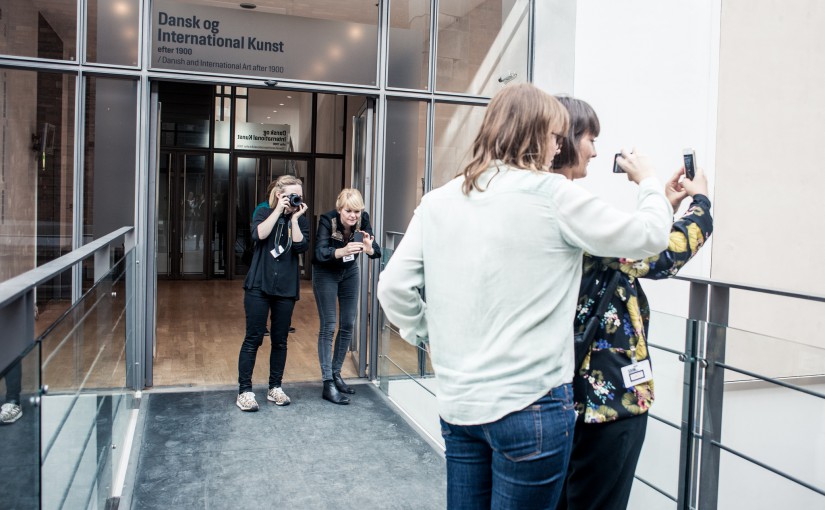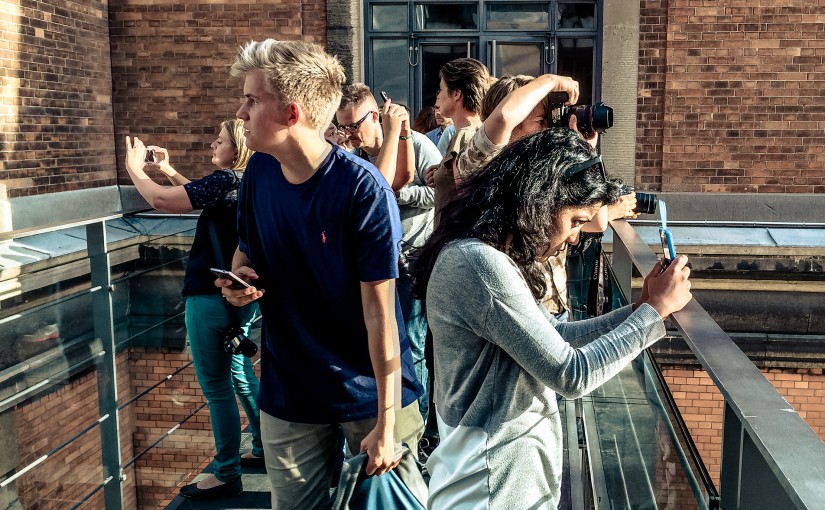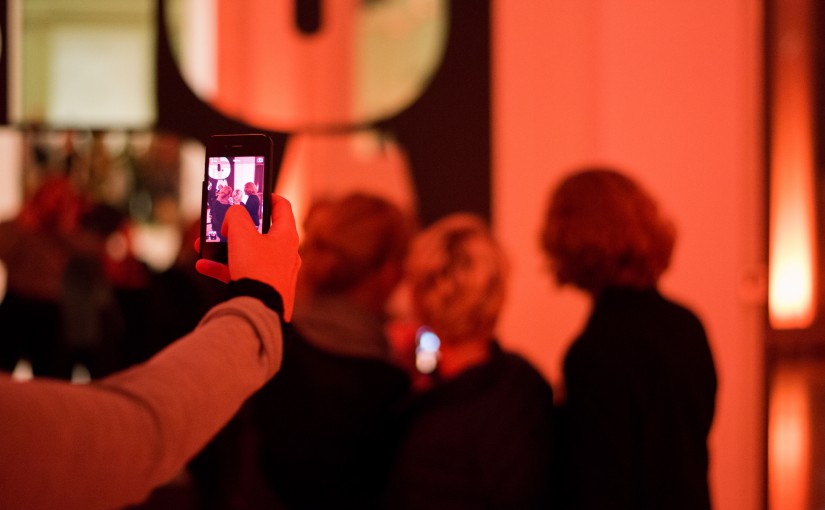Af Ditte Maria Bergstrøm, Projektleder og Digital Ansvarlig, Dansk Kulturarv og Jonas Heide Smith, Ansvarshavende Digital Redaktør, Statens Museum for Kunst
Bragt på Dansk Kommunikationsforenings hjemmeside, juli 2014
De sociale medier frister som glimtende sukkerknalder, og på afdelingsseminaret blev I enige om at prøve det sidste nye. Men kan du også mærke den benhårde virkelighed banke på? Det er tid til at prioritere og opgive tanken om at man kan det hele.
For de fleste organisationer er det langt nemmere at oprette en profil på et socialt medie end at nedlægge den igen. Man når jo faktisk nogle brugere, der kommer jo faktisk hele tiden flere følgere og målsætningerne (og ressourceforbruget) er ikke klart nok defineret til at diktere et tryk på den store delete-knap. I dag er der derfor mange som har strakt sig til bristepunktet i et sympatisk, men forgæves, forsøg på at være alle vegne. Det er tid til at skrue ned for kanalerne og op for fornuften. I denne artikel peger vi på tre “strategiske fokuspunkter” som du med fordel kan måle din digitale kommunikationsindsats imod. Det kan godt være smertefuldt at rydde op, men i sidste ende bliver man en mere effektiv – og sikkert også gladere – kommunikatør. Det er, som et godt gammelt dogme foreskriver, nemmere at ramme plet med elefantbøsse end med spredehagl.
Det digitale landskab
Men lad os starte med at kaste et blik på det digitale landskab og få nogle fakta på bordet. Der hersker ingen tvivl om at vores internetvaner har ændret sig markant de seneste 5 år – og dermed også rammerne for din digitale strategi. Ifølge Danmarks Statistik bruger 84 % af alle danskere mellem 16-84 år internettet dagligt, og 65% af dem har én eller flere profiler på sociale medier. Men uagtet at vi er online som aldrig før, er det kun helt særlige platforme som rammer bredt. Faktisk er det kun tre kanaler, nemlig Google, Facebook og YouTube, der når over 2 millioner danskere om måneden. Så selvom du befinder dig i en verden, hvor platforme som Twitter, Pinterest, Snapchat, Instagram og Flickr, nævnes i flæng, er det altså ikke sikkert at det er dér, I skal prioritere jeres digitale ressourcer.
Og hvis vi skal kaste et blik på landets virksomheder, så har analysebureauet YouGov netop i en undersøgelse vist at 78% af de virksomheder, der er til stede på sociale medier, har en profil på Facebook, mens 19% er på Twitter og YouTube. At hver femte virksomhed har en profil på Twitter, mens kun hver sjette dansker optræder personligt samme sted vidner det om et ønske om en relativ bred tilstedeværelse. Men når mange virksomhedsprofiler samtidig ligger livløse hen, er det et tegn på at man skal tænke sig en om en ekstra gang inden man kaster sig ud på at skulle styre kommunikationen endnu et sted.
Faktaboks: Sådan fordeler danskerne sig på sociale medier
Facebook: 92%
YouTube 66%
Instagram: 10%
Twitter: 15%
Flickr 4%
Kortlæg dine kanaler og undgå overlap
Nogle gange skal man have modet til at sige: So ein ding, muss Ich nicht auch haben. Du har utvivlsomt ikke ret meget tid tilovers i det daglige, så undgå den snigende profildød ved at kortlægge dine kanaler. Find ud af, hvad de eksisterende kanaler kan, og hvis seneste nye sociale medie ikke lokker med et nyt og tydeligt kommunikativt formål, bør du kraftigt genoverveje, om du nu også skal bevæge dig derind.
Måske summer dit netværk i lystig fascination af en ny kanal, men hvis fristelsen bliver for stærk så husk på at mange engang blev hovedkulds forelsket i Second Life. Den tanke kan virke nedkølende.
I sig selv er det hverken svært eller tidskrævende at oprette en profil på Facebook. Men det kan være både svært og tidskrævende at vedligeholde den. Og det er, alt andet lige, mange gange bedre for en virksomheds troværdighed at man ikke møder en profil på et socialt medie end at man møder en misligholdt profil. Møder man en sådan reflekterer det negativt tilbage. For hvis ikke virksomheden har styr på tingene her – hvor sjusker de så ellers?
Det betyder naturligvis ikke, at man skal afholde sig fra at lege og eksperimentere med nye medier og formater. Man skal netop helst udforske og udfordre uden at den samlede digitale kommunikationsstrategi har været tre gange rundt om bordet i direktionen. Mediebilledet anno 2014 flytter sig hurtigt og skal man være der, hvor brugerne befinder sig, giver det ikke mening at komme 5 år for sent. Det er bare vigtigt at man aldrig er bange for at trække stikket, når man indser at dette ikke er et forhold, der kommer til at bære frugt på den lange bane.
Derfor anbefaler vi at den absolut første tommelfingerregel er at man skal stille sig selv spørgsmålet: Hvad er det kommunikative formål med at oprette denne profil?
Her kan det være frugtbart at foretage et overordnet snit mellem sociale medier som typisk når professionelle samarbejdspartnere (fx. LinkedIn og Twitter) og så dem som typisk bruges til kommunikation med slutbrugere (fx. Facebook eller Instagram). Også selvom en skarp skelnen mellem “business-to-consumer”- og “business-to-business”-kommunikation på sociale medier er lidt af en bekvem fiktion, da grænserne er flydende. Dog kan man typisk, afhængigt af organisationens størrelse, angive én kanal til kommunikation om forretningsmæssige forhold og én kanal til samtale med brugerne/kunderne.
Man kan blive yderligere skarp på sine til- og fravalg ved ganske enkelt at opliste strategiske formål for hver kanal. For sociale medier kan disse formål fx være:
- Rekruttering af medarbejdere
- Employer branding
- Kendskabsøgelse
- Krisehåndtering
- Branding
- Marketing/salg
- Opbygning af community
- Kunde-indsigt
Hvis I har for mange kanaler med overlappende formål, bør I stærkt overveje om ikke det er tid til begrænsning.
Et eksempel på en virksomhed med kommunikativt kanalkollaps, er Alm. Brand, der insisterer på at være tilstede på Twitter, uden dog at formå at kommunikere på de præmisser mediet sætter – i stedet refererer profilen konstant til Facebook. Og det er et problem. På mange måder. Dels bliver Twitter konstant en vag kopi af Facebook. Dels kan man ikke følge med på Twitter uden at blive tvunget til at bevæge sig på tværs af platforme – og sidst, men ikke mindst – er det bare sådan noget brugere på Twitter hader. Hvilket er et ret rigtig godt eksempel på, hvorfor det er vigtigt at den, der nu engang styrer kanalen, er fortrolig med den sociale praksis, der udspiller sig på et givent medie. Det vender vi tilbage til under afsnittet “Er I organiseret fornuftigt?”.
Bemærk at kortlægning ikke er ensbetydende med dybsindigt strategiarbejde. Kommunikationsfolk har ikke altid lige let ved at acceptere det, men gode strategier for sociale medier ligner ikke strategier for andre typer arbejde. Selvom indsatsen selvfølgelig skal være tænkt sammen med højere organisationsmål, skal man ikke spilde for meget tid med at forsøge at samtænke – og forudse – hele verden. Tonen, genrerne og fordelingen mellem kanalerne udvikler sig typisk organisk over tid. Og den enkelte platform – her kigger vi på dig, Facebook – kan pludselig skrue på præmisser, design og algoritmer på en så grundlæggende måde at det velmente og tidskrævende strategiarbejde kan være spildt. Forstå sammenhængen mellem jeres medier, skab godt indhold på de enkelte kanalers præmisser og sørg hele tiden for at teste effekten af jeres tiltag – og pensionér så tanken om at basere hele arbejdet på en uigennemskydelig strategi.
Er I organiseret fornuftigt?
Fra den dag hvor den første virksomhed gik på Facebook har man diskuteret hvor de sociale medier bedst håndteres. Er det hos kommunikation? I marketing? I receptionen? Eller måske hos produktudviklerne, som brænder allermest for virksomhedens produkt?
Og skal én person skrive samtlige updates, eller skal opgaven distribueres blandt mange?
Når diskussioner af denne type bølger i mange år uden noget der ligner en afklaring, er det jo gerne fordi der ikke gives nogen klare svar. Samtlige variationer kan fungere.
Noget kan man dog konkludere. De mennesker, der ender med ansvaret skal kende og helst gide det pågældende medie. At tvinge nybegyndere på banen er – også selvom de jo får penge for det – sjældent klogt. Novicer vil bruge uhensigtsmæssigt lang tid på at producere indhold, fordi de ikke er vant til at tænke i socialt indhold og ikke kender konventioner, takt og tone på fingerspidserne. Vores råd er derfor: Hav det overordnede formål for øje, men tænk mennesker før organisationsdiagram i denne sammenhæng.
Overvej i samme åndedrag hvordan I kan få maksimalt udbytte af den krævende indsats. Fastlæg hvordan jeres samlede kanalportefølje bedst spiller sammen. Og ja, her tænker vi genbrug. Indhold fra sociale medier kan helt oplagt benyttes på jeres website (ligesom det kan anvendes på informationsskærme og lignende i den analoge verden). Og de sociale medier kan, i et vist omfang, befrugte hinanden – eksempelvis ved at særligt fantastiske Instagram-billeder nogle gange deles på Facebook. Den samme begivenhed kan også fint afføde indhold på flere forskellige kanaler. Undgå blot ethvert tilløb til automatiseret genbrug; i 2014 opfattes dette af de fleste som decideret dårligt stil og måske endda som en hån mod den kanal hvortil der “krydspostes”.
Dernæst bør I få tre ting helt på plads: Overvågning, publiceringsflow og krisehåndtering.
Som udgangspunkt skal alle sociale profiler overvåges. Det er typisk ikke det store problem på hverdage i arbejdstiden, men hvem tager sig af dialogen i weekenden eller når den ansvarlige person er syg eller på ferie? Om det er ok at vente til mandag morgen og måske endda holde sommerlukket afhænger meget af organisationens type og forhold til sine kunder/brugere. Meget ofte vil det bryde med brugernes forventning.
Og hvad gør man egentlig, når man endelig har fundet noget fornuftigt at skrive? Sørg for at publiceringsflowet er klart for alle og så effektivt som muligt. Skal alle updates godkendes af flere led? I nogle organisationer er det nødvendigt, men for alle gælder det om at der ikke spildes tid med unødvendige procedurer og at enkeltpersoner i godkendelsesprocessen ikke kan fungere som flaskehals. Er det overhovedet muligt, anbefaler vi at updates “efter-godkendes”. Sæt eventuelt et system op der sender ny-udgivne updates til bekymrede parter som så har mulighed for at bede om sletning, hvis de begynder at hyperventilere.
Endelig bør de sociale medier tænkes ind i en større krisehåndteringslogik. For det første kan de dels kan afsløre at en krise er brudt ud, men mange er også efterhånden så vant til at kommunikere på sociale medier, at det ofte er her en klage bliver indledt. Optimalt set bør der eksistere en klar aftale om hvem den kanalansvarlige ringer til i tilfælde af virtuelle optøjer. Er det direktøren? Også lørdag nat? Forventningerne bør afstemmes og er man en klog social medie-redaktør, så kræver man klarhed på dette punkt.
Taler I det rigtige sprog?
Har din organisation kun danske interessenter? Så pris dig lykkelig og spring med god samvittighed dette afsnit over. For så er du forskånet for et af de – overraskende nok – meget svære spørgsmål, nemlig: Hvilket sprog skal vi tale på nettet?
Mange tænker her: Vi opretter da bare en profil (eller website) for hvert sprog! Det kan selvfølgelig i nogle tilfælde være den rigtige beslutning, men vores erfaring er at det er temmelig risikabelt. Det medfører nemlig to overordnede problemer. For det første kæmper mange organisationer med at producere fornuftigt indhold på ét sprog. Profiler på flere sprog risikerer – hvis ikke man er meget skarp på sine workflows – at føre til at en eller flere nedprioriteres eller glemmes helt. Ligesom det nemt kan føre til reduceret motivation hos indholdsproducenter fordi arbejdet bliver tungere eller – hvis materialet skal igennem en oversætter – til forsinket udgivelse. På websites kan flere sprogversioner desuden føre til forvirring omkring hvilken version man skal dele på sociale medier (medmindre man også her har profiler på hvert sprog) og evt. debat om den pågældende side kan blive fragmenteret, så brugerne måske ikke kan se at der foregår en lignende debat på et andet sprog.
Et andet problem er, at eksistensen af flere profiler for samme organisation på samme sociale medie er en direkte opskrift på forvirring. Brugere, der blot foretager en hastig søgning vil ikke nødvendigvis tage sig tid til at overskue en lang række profiler og kan komme til at knytte an til den som – set fra organisations synspunkt – er den forkerte.
Nogle platforme muliggør andre strategier. På Facebook kan man f.eks. segmentere sine updates og dermed, men rimelig præcision, skrive på engelsk til engelsktalende, dansk til dansktalende osv. Det hæver kompleksiteten for redaktøren, mindsker overblikket for Facebook-sidens besøgende og fragmenterer diskussionen, men kan være en fornuftig løsning.
Man kan også, som f.eks. Thorvaldsens Museum vælger at gøre det, bruge to sprog i samme update. Det gør update-teksten ret lang og princippet er ikke nødvendigvis synligt for sidens besøgende, men man undgår nogle af ulemperne ved segmenteringsmetoden.
Samlet set opfordrer vi til at særskilte sprogprofiler på én platform kun oprettes, hvis ingen andre metoder fungerer – eller man har masser af tid og kræfter. Overvej først muligheden for at dedikere en bestemt platform til udenlandske interessenter, så I f.eks. kører Facebook på dansk og Twitter på engelsk. Ideelt er det ikke, men her er vi ikke ikke ude efter idealer, men efter effektivitet og “overlevelse”.
Så for at opsummere
Kortlæg dine kanaler – stil dig selv spørgsmålet: Hvem er målgruppen og hvad er det kommunikative formål? Er svaret herpå for uklart, så tag et grundigt kig på delete-knappen.
Få styr på din organisation, og sørg for at den, der har ansvaret, er vant til at navigere på den givne platform så personen kender det sociale kodeks.
Overvej dit sprog – undgå at øge forvirringen ved at have flere sprogspecifikke profiler på samme sociale platform.
Hvordan skal det hele gå?
Der er ikke længere de helt store forventninger til at de sociale medier indvarsler radikalt nye tider, men samtidig er de blevet et vilkår for de fleste organisationer. De vender ikke op og ned på verden, men man er typisk nødt til at have dem, ligesom man er nødt til at have telefoner, receptioner og Exchange-servere. Og ligesom med disse profane genstande, handler det om at bruge de sociale medier fornuftigt.
Nogle enkelte kan (mener de i hvert fald selv) opstille entydige succes-mål for indsatsen, men langt de fleste har svært ved denne øvelse. Det sidste gælder alle, der arbejder med branding eller med langsigtede mål om at opbygge fællesskaber omkring organisationer eller produkter.
Intet af dette udgør et problem eller indikerer at de sociale medier ikke er væsentlige. Tværtimod er det en fordel ikke at søbe rundt i floromvundne ønskedrømme om de sociale mediers omkalfatrende potentiale. Det gør arbejdet – og prioriteringen – nemmere. Og det gør det nemmere at indse, at succes på sociale medier handler om at udstyre de rigtige mennesker med de rigtige redskaber og så løbende holde mængden af kanaler og initiativer i stram snor. Vi håber, at rådene i denne artikel kan bidrage til dette arbejde.
Kilder
It-anvendelse i befolkningen: Dansk Statistik http://www.dst.dk/pukora/epub/upload/18685/itanv.pdf
Medieudviklingen 2013: DR Medieforskning http://www.dr.dk/NR/rdonlyres/0C32E226-923E-409A-AE8D-D34595DD1C45/5731444/DR_Medieudvikling_2013.pdf
Sociale Medier 2013: Infomedia & YouGov http://www.infomedia.dk/media/77918/sociale-medier-2013-danskernes-holdning-til-og-brug-af-sociale-medier-yougov-smpdk-2013.pdf




































